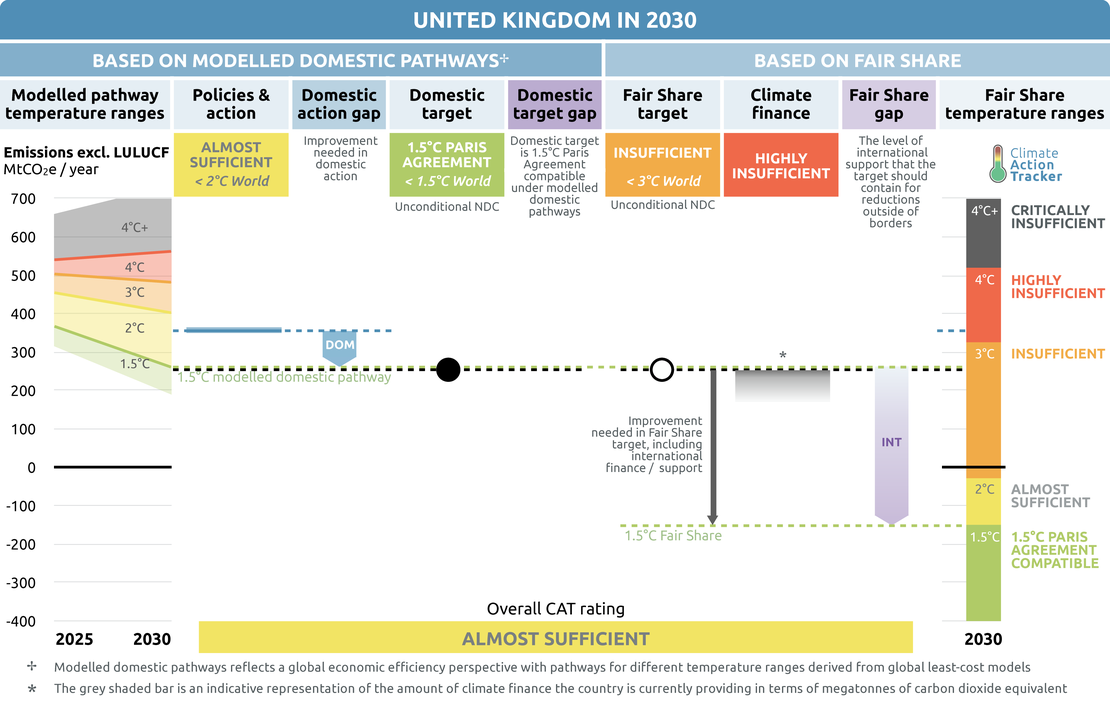Targets
Paris Agreement targets
NOTE: The United Kingdom submitted an updated NDC on 22 September 2022. We are currently analysing this new NDC and will update the United Kingdom country assessment shortly.
NDC and other domestic targets description
Following the adoption of the UK’s landmark Climate Change Act legislation in 2008, the Committee on Climate Change (CCC) was created as an independent statutory advisory body to, among other things, inform the setting of national emission reduction targets. Five initial ‘carbon budgets’ were established in line with the CCC’s advice covering the period between 2008-2032 (Committee on Climate Change, 2019a).
With the release of the CCC’s advice on the sixth carbon budget (2033-2037) in December 2020, the CCC recommended a 2030 target of at least a 68% reduction below 1990 levels alongside a 2035 target representing the average reduction required under the sixth carbon budget: a 78% reduction below 1990 levels. The UK government has since adopted both recommendations, a move that is to be commended. Both domestic targets are 1.5° compatible and make the UK a global climate leader in this regard.
Compliance with the first five carbon budgets is assessed on the basis of the UK’s net carbon account. The net carbon account equals emissions allowances the UK was set to receive under the EU Emissions Trading System (EU ETS), all UK GHG emissions not covered by the EU ETS, and credits/debits from other international credit systems. The sixth carbon budget will be assessed based on actual UK emissions and removals.
The Climate Change Act allows for a limited use of carbon market units for each budget period. For the current third carbon budget (2018-2022), the equivalent of 55 MtCO2e represents the limit on the use of carbon units (Limit on the Net Amount of Carbon Units: Third Carbon Budget, 2016).
The UK’s legally-adopted carbon budgets are as follows:
- 2008-2012: 3,018 MtCO2e
- 2013-2017: 2,728 MtCO2e
- 2018-2022: 2,632 MtCO2e1
- 2023-2027: 1,950 MtCO2e
- 2028-2032: 1,725 MtCO2e
- 2033-2037: 965 MtCO2e
In line with these carbon budgets, the CCC has proposed specific GHG emission reduction targets for 2020, 2025, 2030, and 2035 (Priestley, 2019; Committee on Climate Change, 2020c). These are:
- 2020: 37% below 1990 levels
- 2025: 51% below 1990 levels
- 2030: 57% below 1990 levels2
- 2035: 78% below 1990 levels
In addition to these UK national targets, the Scottish government has legislated the following medium-term targets (Climate Change (Emissions Reduction Targets) (Scotland) Act 2019, 2019):
- 2030: 75% below 1990 levels
- 2040: 90% below 1990 levels
The CAT rates the UK’s domestic 2030 target as “1.5°C Paris Agreement compatible” when rated against modelled domestic pathways (“domestic target”) and as “Insufficient” when rated against its fair share emissions allocation (“fair share target”).
1 | The government has stated that it is carrying forward 88 MtCO2e from its second carbon budget as a contingency plan in case technical changes to the baseline used to measure the UK’s emissions should raise historical emissions; although it has stated that it does not intend to use them. However, as this 88 MtCO2e is available for use, we have included it in our calculations.
2 | This target corresponds to the fifth carbon budget that was set in accordance with achieving the government’s previous 2050 target of an 80% reduction below 1990 levels. The recently updated 68% target was set to align with the current 2050 net zero target.
We rate the UK’s 2030 emissions reduction target of at least 68% below 1990 levels as “1.5°C Paris Agreement compatible” when compared with modelled domestic emissions pathways. The UK’s domestic target does not require other countries to make comparably deeper reductions.
We rate the UK’s 2030 domestic emissions reduction target of at least 68% below 1990 levels as “Insufficient” when compared to its fair-share emissions allocation. The “Insufficient” rating indicates that the UK’s fair-share target in 2030 needs substantial improvement to be consistent with the Paris Agreement’s 1.5°C temperature limit. Some of these improvements should come in the form of additional financial support for emissions reductions achieved in developing countries. If all countries followed the UK’s approach, warming would reach up to 3°C.
The UK’s international climate finance is rated “Highly insufficient” (see below) and is not enough to improve the UK’s fair share rating.

The UK’s international public climate finance contributions are rated “Highly insufficient.” The UK has committed to increase its climate finance, but contributions to date have been very low compared to its fair share. To improve its rating the UK needs to ramp up the level of its international climate finance contributions in the post-2020 period.
Reported contributions fall short of the UK’s fair share contribution to the USD 100bn goal and have decreased in the past five years. Between 2016 and 2020 the UK pledged to provide at least GBP 5.8bn. This commitment has doubled in the period post-2020, to GBP 11.6bn across 2021-2026, however, in July 2021 it was revealed that this would not be new funding, and instead would be taken from the existing aid budget, breaking a UN-brokered agreement that such funding would be ‘new and additional’ (Eckstein et al., 2021; Merrick, 2021; UNFCCC, 2011). This follows an earlier 2021 announcement of a cut in the UK’s total aid budget (Wintour, 2021). A clear and sustained increase in international climate mitigation finance contributions is fundamental in the post-2020 period.
The UK ‘supported GBP 21bn of UK oil and gas exports through trade promotion and export finance’ in the last four years (UK Prime Minister’s Office, 2020). From March 31, 2021, however, the UK stopped investing in fossil fuel projects abroad, covering “export finance, aid funding and trade promotion for new crude oil, natural gas or thermal coal projects” (UK Prime Minister’s Office, 2020). Yet, the UK reserves the right to fund some exceptions. For example, it outlines a set of exemptions to this policy relating to investment in natural gas power plants and infrastructure. Although fossil fuel investments are also excluded from the CDC’s energy portfolio, similar exceptions prevail, too. As part of the G7, the UK also committed to end “new direct government support for unabated international thermal coal power generation by the end of 2021” (G7 United Kingdom, 2021).
Further information on how the CAT rates countries (against modelled domestic pathways and fair share) can be found here.
In late 2020, the UK submitted its first NDC as required after leaving the European Union. The NDC target of at least a 68% reduction in emissions below 1990 levels by 2030 is in line with the target recommended by the Committee on Climate Change, the UK’s statutory climate advisory body, and is rated as a “1.5°C compatible” domestic emissions target.
This target, if achieved, would also place the UK on a path aligned with meeting its 2050 net zero target. However, currently, policies implemented and announced are insufficient to achieve the necessary steep emission reductions to meet its 2030 target. Greater ambition is required across all sectors to ensure this ambitious target is backed up by the action required to achieve it.

Net zero and other long-term target(s)
We evaluate the net zero target as: “Acceptable”.
The UK has enshrined the net zero target by 2050 in law by way of revising and amending the Climate Change Act 2008 in 2019. The Net Zero Strategy released in October 2021 has been submitted to the UNFCCC as the UK’s updated long-term strategy.
The net zero target covers most key elements considered important by the CAT to enhance transparency, target architecture, and scope. The UK meets good practice for most of these benchmarks, but some elements remain undefined or lacking. For example, a clear commitment not to use reductions or removals outside of the UK, and providing separate targets for emissions reductions and removals would improve the target architecture of the UK’s net zero target.
The UK was the first major economy to establish and pass a legally binding target of net zero emissions by 2050 in 2019. The UK’s target covers all sectors and gases and includes emissions from international aviation and shipping. Excluding LULUCF and international aviation and shipping, this corresponds to 2050 emissions of 0 MtCO2e/yr as existing residual emissions from agriculture and other sectors such as international aviation are being balanced by CO2 removal from BECCS, DACCS and other approaches. For this reason, this does not represent a target to reach absolute zero emissions.
For the full analysis click here.
Further analysis
Latest publications
Stay informed
Subscribe to our newsletter





